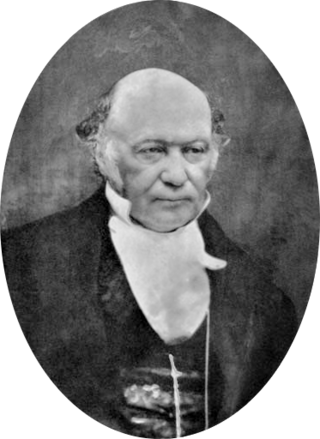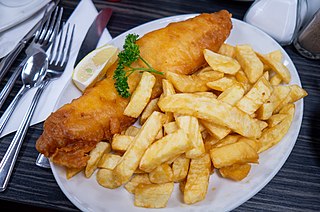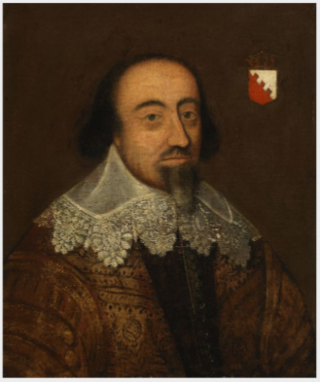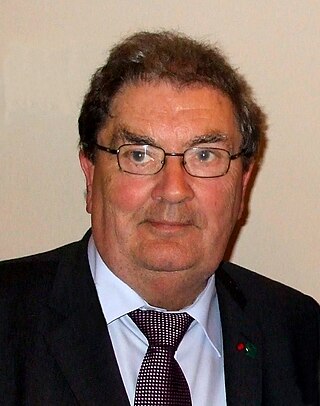Related Research Articles

Sir William Rowan Hamilton MRIA, FRAS was an Irish mathematician, astronomer, and physicist. He was the Andrews Professor of Astronomy at Trinity College Dublin, and Royal Astronomer of Ireland, living at Dunsink Observatory.

Fish and chips is a hot dish consisting of fried fish in batter, served with chips. The dish originated in England, where these two components had been introduced from separate immigrant cultures; it is not known who combined them. Often considered Britain's national dish, fish and chips is a common takeaway food in numerous other countries, particularly English-speaking and Commonwealth nations.

Richard Boyle, 1st Earl of Cork, also known as the Great Earl of Cork, was an English politician who served as Lord Treasurer of the Kingdom of Ireland.
The following is a timeline of low-temperature technology and cryogenic technology. It also lists important milestones in thermometry, thermodynamics, statistical physics and calorimetry, that were crucial in development of low temperature systems.

John JolyFRSMRDS was an Irish physicist and professor of geology at the University of Dublin, known for his development of radiotherapy in the treatment of cancer. He is also known for developing techniques to more accurately estimate the age of a geological period, based on radioactive elements present in minerals, the uranium–thorium dating.
The year 1837 in science and technology involved some significant events, listed below.
The year 1841 in science and technology involved some significant events, listed below.

John Boyd Dunlop was a Scottish inventor and veterinary surgeon who spent most of his career in Ireland. Familiar with making rubber devices, he invented the first practical pneumatic tyres for his child's tricycle and developed them for use in cycle racing. He sold his rights to the pneumatic tyres to a company he formed with the president of the Irish Cyclists' Association, Harvey du Cros, for a small cash sum and a small shareholding in their pneumatic tyre business. Dunlop withdrew in 1896. The company that bore his name, Dunlop Pneumatic Tyre Company, was not incorporated until later using the name well known to the public, but it was Du Cros's creation.
The year 1857 in science and technology involved some significant events, listed below.
The year 1844 in science and technology involved some significant events, listed below.
This article details the history of electrical engineering.
Events from the year 1770 in Ireland.
Charles Jasper Joly was an Irish mathematician and astronomer who was Andrews Professor of Astronomy from 1897 until his death in 1906. He was an important figure in the study of quaternions.

Ireland's Greatest was a 2010 public poll by Raidió Teilifís Éireann (RTÉ) and associated television documentary series broadcast on RTÉ One, where viewers voted to choose the greatest person in the history of Ireland. The concept was based on the BBC series 100 Greatest Britons. The winner was John Hume.

A Declaration Concerning the newly invented Art of Double Writing was a pamphlet of 6 leaves, written by Sir William Petty (1623–1687) and first published in 1648. It contained information regarding his invention of the "Art of Double Writing", especially a claim for patent rights. It did not contain any information on what his invention exactly was.
The 19th century in science saw the birth of science as a profession; the term scientist was coined in 1833 by William Whewell, which soon replaced the older term of (natural) philosopher.
References
- ↑ "The ancient Irish alphabet Ogham explained". IrishCentral.com. 11 May 2017. Retrieved 3 March 2018.
- ↑ Association, Gaelic Athletic (15 December 2015). "GAA: Hurling History and Evolution". www.gaa.ie.
- ↑ Saenger, Paul (1997). Space Between Words. Stanford University Press.
- ↑ Foxall, Damian (2011). Ocean Fever: The Damian Foxall Story. The Collins Press. p. 41. ISBN 9781848899490.
- ↑ "Road Bowling". Culture Northern Ireland. 2 February 2006. Retrieved 3 March 2018.
- ↑ Principe, Lawrence (5 January 2011). "In retrospect: The Sceptical Chymist". Nature. 469 (7328): 30–31. Bibcode:2011Natur.469...30P. doi: 10.1038/469030a .
- ↑ "Boyle's law - chemistry". Encyclopedia Britannica. Retrieved 3 March 2018.
- ↑ "More than just the chocolate man: The story of Hans Sloane". The Irish News. 10 September 2016. Retrieved 3 March 2018.
- ↑ Eveleth, Rose (12 February 2014). "Chocolate Milk Was Invented in Jamaica". Smithsonian Magazine. Retrieved 9 October 2021.
- ↑ "How Entrepreneurship Theory Created Economics". Mises Institute. 21 August 2014. Retrieved 3 March 2018.
- ↑ "Beaufort scale". Encyclopedia Britannica. Retrieved 2 March 2018.
- ↑ "Stomach upset innovator honoured". BBC News. 25 February 2005. Retrieved 2 March 2018.
- ↑ Brief History of the Miner's Flame Safety Lamp Archived 26 August 2003 at the Wayback Machine
- ↑ "Edward Bransfield - British explorer". Encyclopedia Britannica. Retrieved 2 March 2018.
- ↑ "10 Irish inventions that changed the world".
- ↑ Yenne, Bill (2007). Guinness: The 250 Year Quest for the Perfect Pint . John Wiley & Sons. p. 205. ISBN 9780470120521.
- ↑ Carlton, Carla Harris (2017). Barrel Strength Bourbon: The Explosive Growth of America's Whiskey. Clerisy Press. p. 113. ISBN 9781578605767.
- ↑ Standards, United States National Bureau of (1927). Standards and Specifications in the Wood-using Industries: Nationally Recognised Standards and Specifications for Wood and Manufactures Thereof Including Paper and Paper Products ... October 5, 1927 ... U.S. Government Printing Office. p. 76.
- ↑ "An Irishwoman's Diary". The Irish Times. Retrieved 2 March 2018.
- ↑ "History is made as Darver man gets science award". Independent.ie. Retrieved 3 March 2018.
- ↑ "Sir William Rowan Hamilton - Irish mathematician and astronomer". Encyclopedia Britannica. Retrieved 3 March 2018.
- ↑ "The Irish doctor who invented the syringe". The Irish Times. Retrieved 3 March 2018.
- ↑ "Discoveries - Lord Kelvin - National Library of Scotland". digital.nls.uk. Retrieved 3 March 2018.
- ↑ Prynne, Miranda (201). "A history of the stethoscope". The Telegraph. Archived from the original on 20 February 2016. Retrieved 3 March 2018.
- ↑ Weerden, Anne van (2017). A Victorian Marriage: Sir William Rowan Hamilton. J. Fransje van Weerden. p. 232. ISBN 9789463230025.
- ↑ Graham, Steve (8 October 1999). "John Tyndall : Feature Articles". earthobservatory.nasa.gov. Retrieved 3 March 2018.
- ↑ "Atlantic Cable". special.lib.gla.ac.uk. Retrieved 3 March 2018.
- ↑ "George Johnstone Stoney - Irish physicist". Encyclopedia Britannica. Retrieved 3 March 2018.
- ↑ Everett, H. R.; Toscano, Michael (2015). Unmanned Systems of World Wars I and II. MIT Press. p. 33. ISBN 9780262331760.
- ↑ "Cream Crackers – An Authentically Irish Snack". Irish American Mom. 26 October 2012. Retrieved 3 March 2018.
- ↑ "John Robert Gregg - American stenographer". Encyclopedia Britannica. Retrieved 3 March 2018.
- ↑ Hirsch, Robert (2014). Exploring Color Photography Sixth Edition: From Film to Pixels. CRC Press. p. 21. ISBN 9781317911159.
- ↑ "John Joly,Trinity College Dublin biography". Trinity College Dublin. Retrieved 27 January 2019.
- ↑ "John Holland Father of the Modern Submarine". Archived from the original on 6 October 2013. Retrieved 5 October 2013.
- ↑ Aukstakalnis, Steve (2016). Practical Augmented Reality: A Guide to the Technologies, Applications, and Human Factors for AR and VR. Addison-Wesley Professional. p. 29. ISBN 9780134094359.
- ↑ "The Irish man who brought radiotherapy forward". The Irish Times. Retrieved 2 March 2018.
- ↑ "Harry Ferguson: Planes, tractors and automobiles". BBC Timelines. Retrieved 2 March 2018.
- ↑ "Flashback 1931 - first journey of battery-powered train - Independent.ie". Independent.ie. 6 December 2015. Retrieved 2 March 2018.
- ↑ Cambridge Physics - Splitting the Atom
- ↑ "British History - Ejection Seat". BBC - Primary History. Retrieved 2 March 2018.
- ↑ "Joe 'Spud' Murphy: The Man Who Gave Potato Chips Flavor". HuffPost . 20 April 2012.
- ↑ Hochman, Karen. "A History of the Potato Chip: Page 4: The First Salted & Flavored Potato Chips". The Nibble.
- ↑ Crutchley, Peter (3 October 2016). "'Father of emergency medicine' celebrated". BBC News. Retrieved 2 March 2018.
- ↑ "Kilkenny woman invents best thing since blu-Tack and Sellotape". Kilkenny People . 25 January 2010. Archived from the original on 1 February 2010. Retrieved 6 February 2010.
- ↑ Who invented the spice bag? , retrieved 21 December 2020 (Originally broadcast on The Business on RTE Radio 1 on 27/08/2016.)